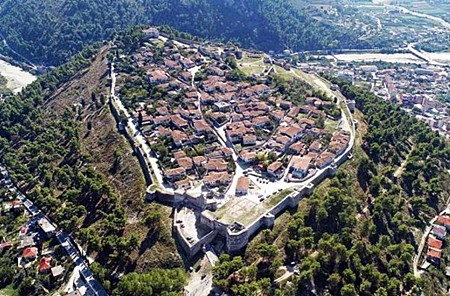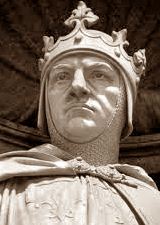
Battle of Berat |
year: 12811280-1281 |
| A Byzantine victory against the forces of Charles D’ Anjou | ★ ★ ★ ★ ★ |
|
enemy: Angevins of Sicily
|
location: Modern Berat in Central Albania
|
accuracy:
●●●●●
|
|
battle type: Siege |
war: Neapolitan-Byzantine War |
modern country:
Albania |
| ▼ The Byzantines(emperor: Michael VIII Palaiologos) | ▼ The Enemies | |
| Commander: | General Michael Glavas Tarchaneiotes | Hugo de Sully |
| Forces: | Unknown | 8,000 |
| Losses: | Probably light | Heavy |
| Background story: |
| Ever since the Emperor Michael VIII Palaiologos recovered Constantinople from the Latin Empire in 1261, the Byzantium faced the threat of a Latin crusade to reclaim the city. The antagonistic Greek Despotate of Epirus and the Latin states of southern Greece, fearful of the Byzantine resurgence, sought aid from the Kingdom of Sicily, first under Manfred of Sicily (r.1258–1266), and after 1266 under the ambitious Charles D’ Anjou (r.1266–1285), who quickly established himself as Byzantium's chief antagonist. In 1257, the Sicilians took possession of the island of Corfu and the Albanian coast, from Dyrrhachium to Valona and Buthrotum and as far inland as Berat. After overthrowing and killing Manfred (1266) Charles of Anjou secured his recognition as Manfred's heir. In 1272, the Latin nobles who had held the fortresses of Valona, Kanina, and Berat for Manfred surrendered them to Charles, and soon afterwards Charles's troops took Dyrrhachium too. Having secured the support of many Albanian chieftains, Charles proclaimed the establishment of the Kingdom of Albania in the same year, with him as a king. Taking advantage of Charles's entanglement in the conflict between Guelphs and Ghibellines in Italy, in spring 1274 Michael VIII launched an attack against Angevin holdings in Albania. Berat and Buthrotum were taken and Charles's troops were pushed back from the hinterland to the two ports of Valona and Dyrrhachium. By 1279 however, Charles had established his control not only over the Latin states of Greece (after 1278 he was the Prince of Achaea), but also received the submission and vassalage of Nikephoros I, Despot of Epirus.  Aerial view of the Berat castle |
The Battle: |
 Charles D’ Anjou Meanwhile, the siege of Berat continued through the winter of 1280/1281. By early December, the Angevin forces had seized a number of forts around the city, but Charles D’ Anjou was anxious to take the city before the Byzantine relief force arrived. The Byzantine force advanced cautiously, and arrived in the area in early spring 1281. Tarchaneiotes avoided a direct confrontation and relied on ambushes and raids instead. He also managed to resupply the besieged fortress with provisions, which were loaded onto rafts and then left to float down the river Osum which flows by the citadel. At this point, Sully resolved to scout the area personally, accompanied only by a bodyguard of 25 men. As he approached the Byzantine camp, he fell into an ambush by Turkish mercenaries of the Byzantine army. The Turks attacked the small troop, killed Sully's horse, scattered his guard, and captured him. A few of Sully's guards escaped and reached their camp, where they reported his capture. Panic spread among the Angevin troops at this news, and they began to flee towards Valona (Avlon). The Byzantines took advantage of their disordered flight and attacked, joined by the troops in the besieged citadel. Many Latins fell, many others were captured as the Byzantines aimed their arrows at the less well-protected horses of the Latin knights, unhorsing them. The Byzantines also took an enormous booty, including all the numerous siege machines. Only a small remnant managed to cross the river Vjosë and reach the safety of Kanina. |
Aftermath: |
| It was the biggest victory of Michael VIΙI against the Latins and was celebrated with a triumph in the capital. The plans of Charles D’Anjou to invade Byzantium were delayed and canceled later, when Michael incited the Sicilian Vespers (in 1282). |
|
|
